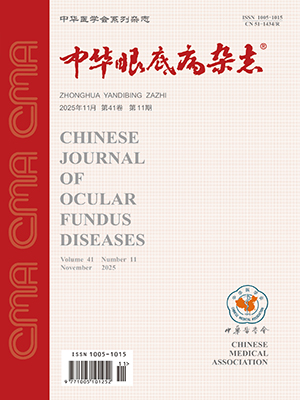| 1. |
Tsang SH, Sharma T. Progressive cone dystrophy and cone-rod dystrophy (XL, AD, and AR)[J]. Adv Exp Med Biol, 2018, 1085: 53-60. DOI: 10.1007/978-3-319-95046-4_12.
|
| 2. |
Hamel CP. Cone rod dystrophies[J]. Orphanet J Rare Dis, 2007, 2: 7. DOI: 10.1186/1750-1172-2-7.
|
| 3. |
盛迅伦. 视锥细胞营养不良和视锥-视杆细胞营养不良[M]//盛迅伦, 庄文娟. 遗传性眼病的基础与临床. 北京: 人民卫生出版社, 2019: 120-122.Sheng XL. Cone dystroph and cone-rod dystrophy[M]//Sheng XL, Zhuang WJ. Foundation and clinic of hereditary eye diseases. Beijing: People's Medical Publishing House, 2019: 120-122.
|
| 4. |
Nakajima D, Nakayama M, Kikuno R, et al. Identifification of three novel non-classical cadherin genes through comprehensive analysis of large cDNAs[J]. Brain Res Mol Brain Res, 2001, 94(1-2): 85-95. DOI: 10.1016/s0169-328x(01)00218-2.
|
| 5. |
Sharon D, Blackshaw S, Cepko CL, et al. Profifile of the genes expressed in the human peripheral retina, macula, and retinal pigment epithelium determined through serial analysis of gene expression (SAGE)[J]. Proc Natl Acad Sci USA, 2002, 99(1): 315-320. DOI: 10.1073/pnas.012582799.
|
| 6. |
Rattner A, Chen J, Nathans J. Proteolytic shedding of the extracellular domain of photoreceptor cadherin Implications for outer segment assembly[J]. J Biol Chem, 2004, 279(40): 42202-42210. DOI: 10.1074/jbc.M407928200.
|
| 7. |
Rattner A, Smallwood PM, Williams J, et al. A photoreceptor- specifific cadherin is essential for the structural integrity of the outer segment and for photoreceptor survival[J]. Neuron, 2001, 6,32(5): 775-786. DOI: 10.1016/s0896-6273(01)00531-1.
|
| 8. |
Ostergaard E, Batbayli M, Duno M, et al. Mutations in PCDH21 cause autosomal-recessive cone-rod dystrophy[J]. J Med Genet, 2010, 47(10): 665-669. DOI: 10.1136/jmg.2009.069120.
|
| 9. |
Henderson RH, Li Z, Abd El Aziz MM, et al. Biallelic mutation of protocadherin-21 (PCDH21) causes retinal degeneration in humans[J]. Mol Vis, 2010, 16: 46-52.
|
| 10. |
Fu J, Ma L, Cheng J, et al. A novel, homozygous nonsense variant of the CDHR1 gene in a Chinese family causes autosomal recessive retinal dystrophy by NGS-based genetic diagnosis[J]. J Cell Mol Med, 2018, 22(11): 5662-5669. DOI: 10.1111/jcmm.13841.
|
| 11. |
Stingl K, Mayer AK, Llavona P, et al. CDHR1 mutations in retinal dystrophies[J/OL]. Sci Rep, 2017, 7(1): 6992[2017-08-01]. https://pubmed.ncbi.nlm.nih.gov/28765526/. DOI: 10.1038/s41598-017-07117-8.
|
| 12. |
Haque MN, Kurata K, Hosono K, et al. A Japanese family with cone-rod dystrophy of delayed onset caused by a compound heterozygous combination of novel CDHR1 frameshift and known missense variants[J]. Hum Genome Var, 2019, 6: 18. DOI: 10.1038/s41439-019-0048-8.
|
| 13. |
Gerth-Kahlert C, Tiwari A, Hanson JVM, et al. C2orf71 mutations as a frequent cause of autosomal-recessive retinitis pigmentosa: clinical analysis and presentation of 8 novel mutations[J]. Investig Opthalmology Vis Sci, 2017, 58(10): 3840-3850. DOI: 10.1167/iovs.17-21597.
|
| 14. |
Corral-Serrano JC, Lamers IJC, et al. PCARE and WASF3 regulate ciliary F-actin assembly that is required for the initiation of photoreceptor outer segment disk formation[J]. Proc Natl Acad Sci USA, 2020, 117(18): 9922-9931. DOI: 10.1073/pnas.1903125117.
|
| 15. |
Collin RW, Safieh C, Littink KW, et al. Mutations in C2ORF71 cause autosomal recessive retinitis pigmentosa[J]. Am J Hum Genet, 2010, 86(5): 783-788. DOI: 10.1016/j.ajhg.2010.03.016.
|
| 16. |
Serra R, Floris M, Pinna A, et al. Novel mutations in c2orf71 causing an early onset form of cone rod dystrophy: a molecular diagnosis after 20 years of clinical follow-up[J]. Mol Vis, 2019, 25: 814-820.
|




